fuel BUICK SKYLARK 1993 Owners Manual
[x] Cancel search | Manufacturer: BUICK, Model Year: 1993, Model line: SKYLARK, Model: BUICK SKYLARK 1993Pages: 306, PDF Size: 15.84 MB
Page 13 of 306
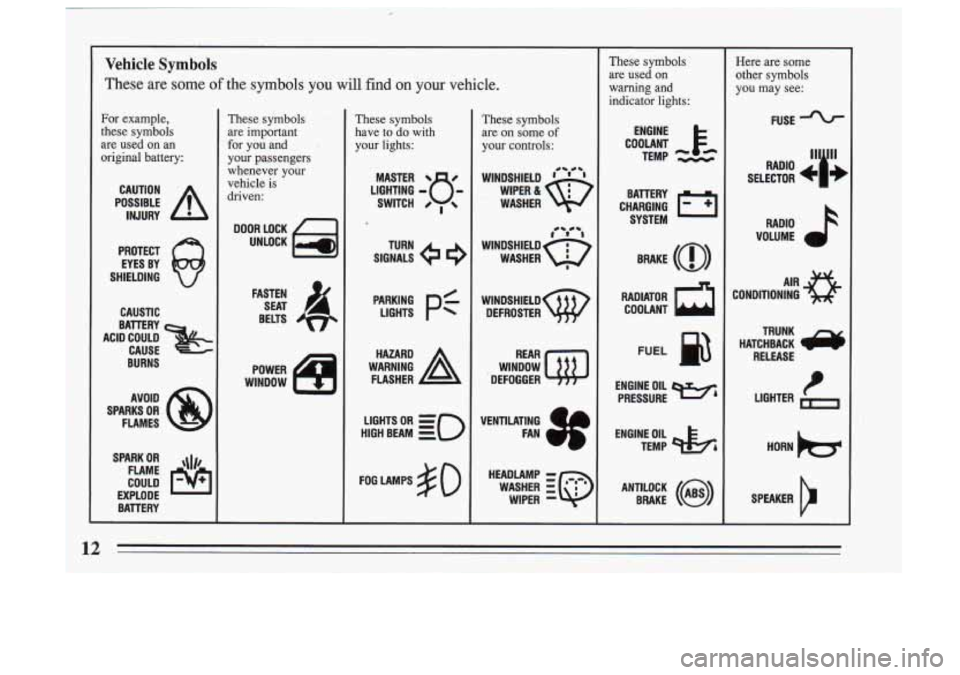
Vehicle Symbols
These are some of the symbols you will. find -on your vehicle.
For example,
these symbols
are used on an
original battery:
CAUTION
INJURY
PROTECT EYES BY
SHIELDING
Q
CAUSTIC
ACID COULD CAUSE
BA~~RY
BURNS AVOID
SPARKS
OR
FLAMES
SPARK
OR ,\I/,
COULD pq
FLAME
EXPLODE BATTERY
These symbols
are important
for you and
your passengers
whenever your
vehicle- is
driven:
FASTEN SEAT 4
BELTS
POWER
WINDOW
These symbols
have to do with
your lights:
SIGNALS e 9
TU-RN
HIGH BEAM
OR = =o
FOG LAMPS # 0
These symbols
are on some of
your controls:
WINDSHIELD ' ' '
. WASHER
CI 0s
-tO -1
WINDSHIELD
WASHER 8
wI*DsHIELDw DEFROSTER
WINDOW
Ltft,
REAR
DEFOGGER
VENTILATING FAN
3f
HEADLAMP -
WIPER
WASHER
EQ
L
~
These symbols
are used
on
warning and
indicator lights:
COOLANT F-
TEMP *-
ENGINE
CHARGING BATTERY
SYSTEM
RADIATOR
a
COOLANT
FUEL @
ENGINE OIL e,
PRESSURE
TEMP
OIL &
ANTILOCK (@)
BRAKE
Here are some
other symbols
you may see:
FUSE
RAD10 k
VOLUME
CONDITIONING
AIR e
HATCHBACK TRUNK
RELEASE
LIGHTER
1-i
HORN
SPEAKER
12
Page 77 of 306
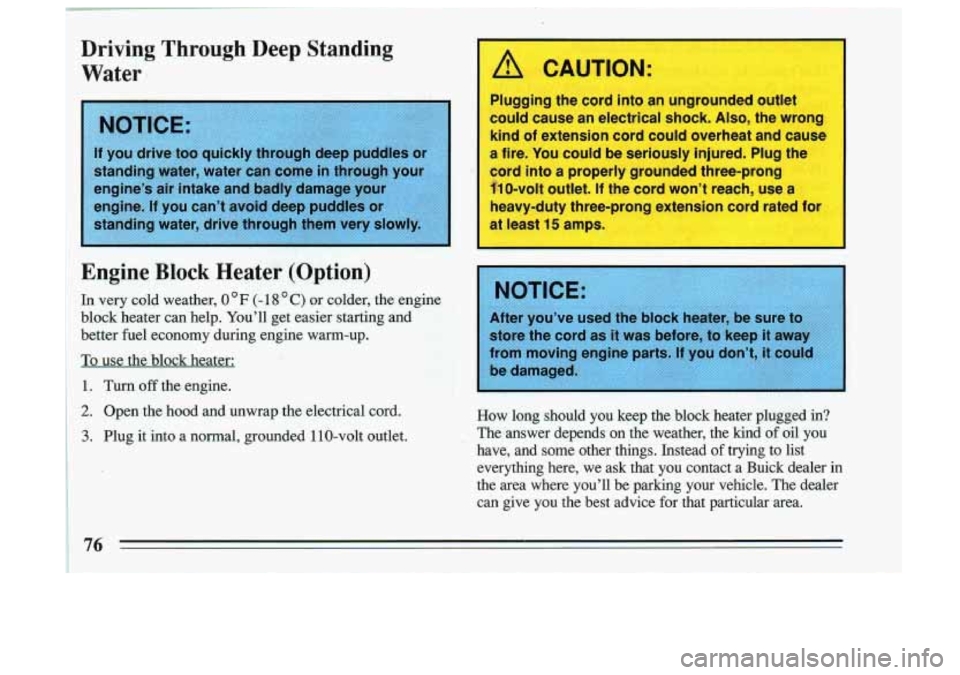
Driving Through Deep Standing
Water
If you drive too quickly through deep puddles 01
standing water, water can come in through
engine’s air intake and badly damage your
engine.
If you can’t avoid deep puddles or
standing water, drive through them very slowly.
Engine Block Heater (Option)
In very cold weather, O°F (-18 “C) or colder, the engine
block heater can help. You’ll get easier starting and
better fuel economy during engine warm-up.
To use the block heater:
1. Turn off the engine.
2. Open the hood and unwrap the electrical cord.
3. Plug it into a normal, grounded 110-volt outlet.
1 A
CAUTION:
Plugging the cord into an ungrounded outlet
could cause an electrical shock.
Also, the wrong
kind of extension cord could overheat and cause
a fire. You could be seriously injured. Plug the
cord into a properly grounded three-prong
110-volt outlet.
If the cord won’t reach, use a
heavy-duty three-prong extension cord rated for
at least
15 amps.
I
How long should you keep the block heater plugged in?
The answer depends on the weather, the kind of oil you
have, and some other things. Instead
of trying to list
everything here, we ask that you contact a Buick dealer in
the area where you’ll be parking
your vehicle. The dealer
can give you the best advice for that particular area.
Page 80 of 306
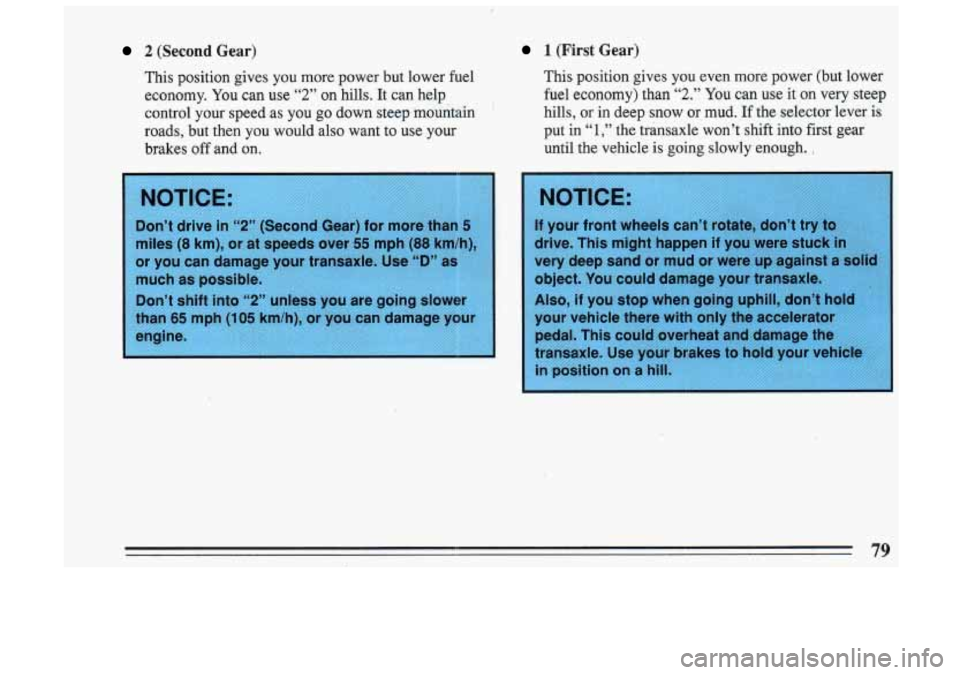
2 (Second Gear)
This position gives you more power but lower fuel
economy. You can use
“2” on hills. It can help
control your speed as you go down steep mountain
’
roads, but then you would also want to use your
brakes
off and on.
1 (First Gear)
This position gives you even more power (but lower
fuel economy) than
“2.” You can use it on very steep
hills, or in deep snow or mud.
If the selector, lever is
put in
“1,” the transaxle won’t shift into first gear
until the vehicle
is going slowly enough. ,
Don’t drive in “2” (Second Gear) for more than 5
miles (8 km), or at speeds over 55 mph (88 km/h),
or you can damag ansaxl
much as possible.
Don’t shift into “2” unless you are going
slower
than 65 mph (105 km/h), or you can damage your
engine.
79
Page 108 of 306
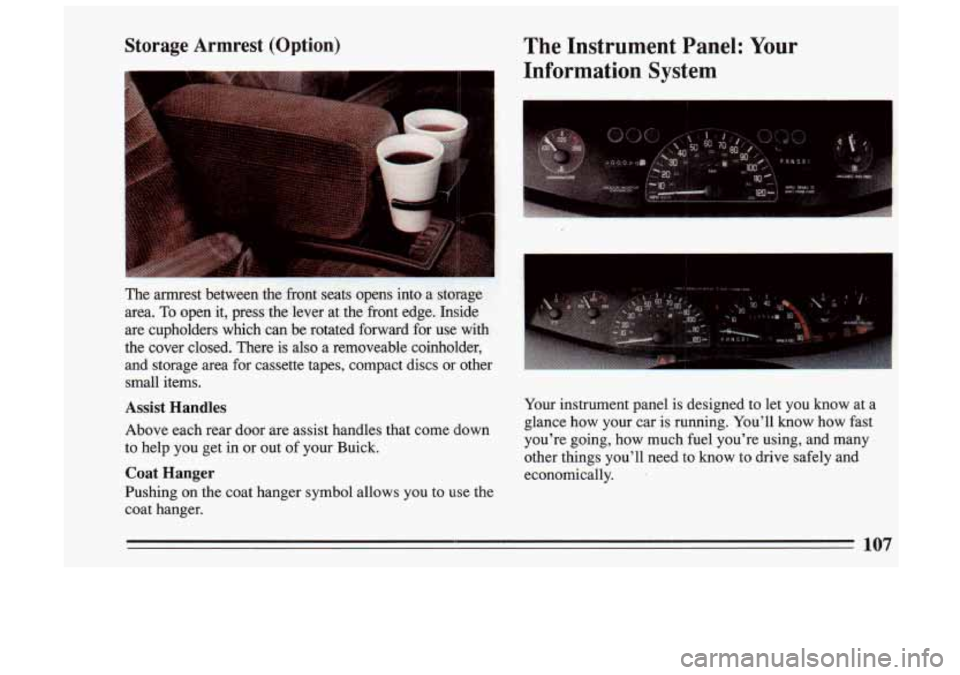
Storage Armrest (Option) The Instrument Panel: Your
Information System
The armrest between the front seats opens' into a storage.
area.
To open it, press the lever at the front edge. Inside
are cupholders which can. be rotated forward for
use with
the cover closed. There is also a removeable coinholder,
and storage area for cassette tapes, compact discs or other small items.
Assist Handles
Above each rear door are as-sist handles that come down
to help you get in or out of your Buick.
Coat Hanger
Pushing on the coat hanger symbol allows you to use the
coat hanger. Your
instrument panel
is designed to let you know at a
glance how your car is running. You'll know
how fast
you're going, how much fuel you're using, and many
other things you'll need to know to drive safely and
economically.
.
Page 110 of 306
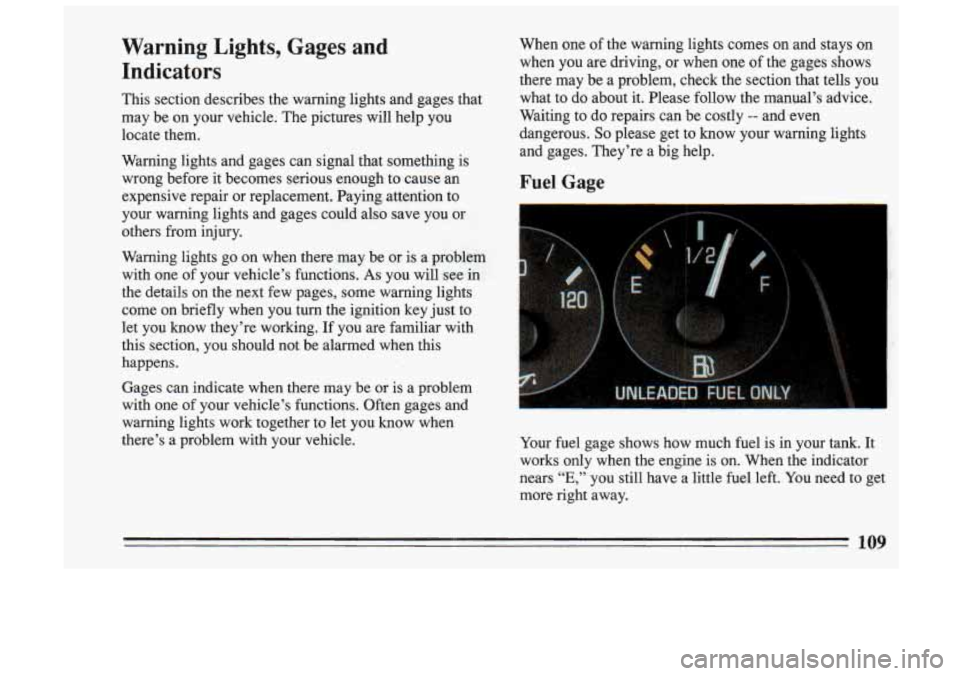
Warning Lights, Gages and
Indicators
This section describes the warning lights and gages that
may be on your vehicle. The pictures will help you
locate them.
Warning lights and gages can signal that something is wrong before it becomes serious enough to cause an
expensive repair or replacement. Paying attention to
your warning lights and gages could also save you or
others from injury.
Warning lights go on when there may be or is a problem with one of your vehicle’s functions.
As you will see in
the details
on the next few pages, some warning lights
come on briefly when you turn the ignition key just to
let you know they’re working. If you are familiar with
this section, you should not be alarmed when this
happens.
Gages can indicate when there may be or is a problem
with one of your vehicle’s functions. Often gages and
warning lights work together to let you know when
there’s a problem with your vehicle. When
one
of the warning lights comes on and stays on
when you are driving, or when one of the gages shows
there may be a problem, check the section that tells you what to do about it. Please follow the manual’s advice.
Waiting to do repairs can be costly
-- and,even
dangerous.
So please get to know your warning lights
and gages. They’re a big help.
Fuel Gage
Your fuel gage shows how much fuel is in your tank. It
works only when the engine is on. When the indicator
nears
“E,” you still have a little fuel left. You need to get
more right away.
Page 114 of 306

Low Coolant Warning Light
If this light comes on, your
system is low on coolant
and the engine may
overheat.
Malfunction Indicator Lamp (Service Engine Soon Light)
See “Engine Coolant’’ in the Index and have your
vehicle serviced as
soon as you can. A computer monitors operation of your fuel, ignition
and emission control systems. This light should come on when the ignition is on,
but the engine is not running, as
a check
to show you it is working. If it does not come on
at all, have it fixed right away. If
it stays on, or it comes
on while you are driving, the computkr is indicating that
you have a problem. You should take your vehicle in for
service soon.
Page 169 of 306
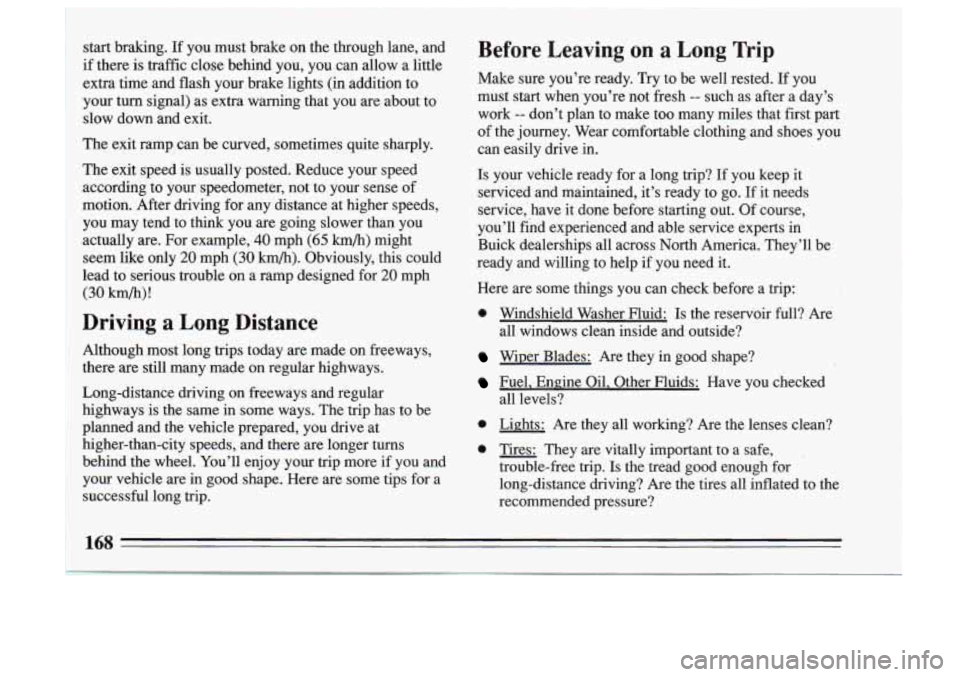
start bralung. If you must brake on the through lane, and
if there
is traffic close behind you, you can allow a little
extra time and flash your brake lights (in addition to your turn signal) as extra warning that you are about to
slow down and exit.
The exit ramp can be curved, sometimes quite sharply.
The exit speed is usually posted. Reduce your speed
according to your speedometer, not to your sense of
motion. After driving for any distance at higher speeds,
you may tend to think you are going slower than you
actually are. For example,
40 mph (65 km/h) might
seem like only
20 mph (30 km/h). Obviously, this could
lead to serious trouble on a ramp designed for
20 mph
(30 krn/h)!
Driving a Long Distance
Although most long trips today are made on freeways,
there are still many made on regular highways.
Long-distance driving on freeways and regular
highways is the same in some ways. The trip has to be
planned and the vehicle prepared, you drive at
higher-than-city speeds, and there are longer turns
behind the wheel. You’ll enjoy your trip more if you and
your vehicle are
in good shape. Here are some tips for a
successful long trip.
Before Leaving on a Long Trip
Make sure you’re ready. Try to be well rested. If you
must start when you’re not fresh
-- such as after a day’s
work
-- don’t plan to make too many miles that first part
of the journey. Wear comfortable clothing and shoes you
can easily drive in.
Is your vehicle ready for a long trip? If you keep it
serviced and maintained, it’s ready to go. If it needs
service, have it done before starting out. Of course,
you’ll find experienced and able service experts in
Buick dealerships all across North America. They’ll be
ready and willing to help
if you need it.
Here are some things you can check before a trip:
0 Windshield Washer Fluid: Is the reservoir full? Are
all windows clean inside and outside?
WiDer Blades: Are they in good shape/
Fuel, Engine Oil, Other Fluids: Have you checked
all levels?
0 Lights: Are they all working? Are the lenses clean?
0 Tires: They are vitally important to a safe,
trouble-free trip. Is the tread good enough for long-distance driving?
Are the tires all inflated to the
recommended pressure?
168
Page 180 of 306

Towing a Trailer
A CAUTION:
If you don’t use the correct equipment and drive
properly, you can lose control when you pull
a
trailer. For example, if the trailer is too heavy. the
brakes may not work well
-- or even at all. Yo
and your passengers could be seriously injured.
Pull
a trailer only if you have followed all the
steps in this section.
i ~ ~, ~~ ~~
~~~ ~~ before you pull a trailer.
Your
car can tow a trailer.
To identify what the vehicle
trailering capacity is for your vehicle, you should read
the information in “Weight of the Trailer”. that appears
I later in this section. But trailering is different than just
driving your vehicle by itself. Trailering means changes
I in. handling, durability, and fuel economy. Successful,
safe trailering takes correct equipment, and it has to be
I used properly.
That’s the reason for this section. In it are many
time-tested, important trailering tips and safety rules. Many of these are important for your safety and that of
I your passengers. So please read this section carefully
Load-pulling components such as the engine, transaxle, wheel assemblies, and tires are forced to work harder
against the drag of the added weight. The engine is
greater loads, generating extra heat. What’s more, the
trailer adds considerably to wind resistance, increasing
the pulling requirements.
All of that means changes in:
ulling a trailer improper1 required to operate at relatively higher speeds and under
Do not tow a trailer if your vehicle is equipped with the
0 Handling
2.3 Liter, L4 engine. Durability
Fuel economy
179
Page 218 of 306

Fuel
Use regular unleaded gasoline rated at 87 octane or
higher. It should meet specifications ASTM D48
14 in
the U.S. and CGSB
3.5-92 in Canada. These fuels
should have the proper additives,
so you should not have
to add anything to the fuel.
In the U.S. and Canada, it’s easy to be sure you get the \
right kind of gasoline (unleaded). You’ll see
“UNLEADED” right on the pump. And only unleaded
nozzles will fit into your vehicle’s filler neck.
Be sure the posted octane is at least
87. If the octane is
less than
87, you may get a heavy knocking noise when
you drive.
If it’s bad enough, it can damage your engine.
If you’re using fuel rated at
87 octane or higher and you
still hear heavy knocking, your engine needs service. But don’t worry if you hear a little pinging noise when
you’re accelerating
or driving up a hill. That’s normal,
and you don’t have to buy a higher octane fuel to get rid\
of pinging. It’s the heavy, constant knock that means
you have a problem.
What about gasoline with blending materials that contain oxygen, such as MTBE or alcohol?
MTBE is “methyl tertiary-butyl ether.” Fuel that
is no
more than
15% MTBE is fine for your vehicle. Ethanol is ethyl or grain alcohol. Properly-blended fuel
that is no more than
10% ethanol is
fine for your
vehicle.
Methanol is methyl or wood alcohol.
Gasolines for Cleaner
Air
Your use of gasoline with detergent additives will help
prevent deposits from forming in your engine and fuel
system. That helps keep your engine in tune and your
emission control system working properly. It’s good for
your vehicle, and you’ll be doing your part for cleaner
air.
Many gasolines are now blended with materials called
oxygenates. General Motors recommends that you use
217
Page 221 of 306
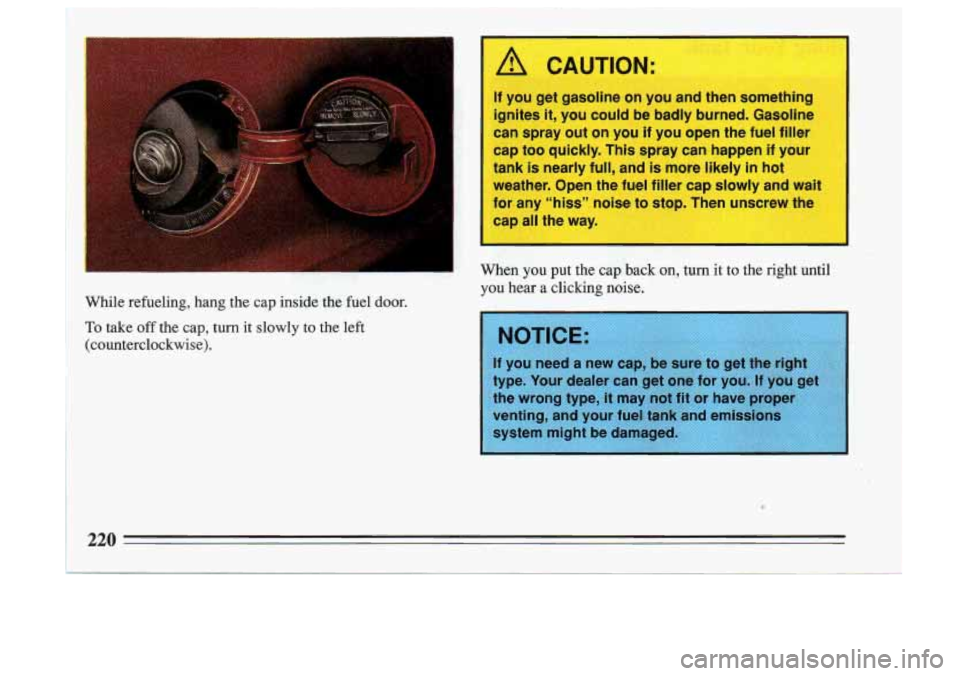
A CAUTION:
If you get gasoline on you and then something
ignites
it, you could be badly burned. Gasoline
can spray out on you if you open the fuel filler
cap too quickly. This spray can happen
if your
tank is nearly full, and is more likely
in hot
weather. Open the fuel filler cap slowly and wait
for any “hiss” noise to stop. Then unscrew the
cap all the way.
m Y, When you put the cay ----I on, turn it to the right until a- .~ : _, .. . I. ’
YOU hear a clicking noise.
While refueling, hang the cap inside the fuel
door. .
To take off the cap, turn it slowly to the left
(counterclockwise).
4 Y
pe. Your dealer can get one for you. If you get
e wrong type,
it may not fit or have prope
enting, and your fuel tank and emissions
220